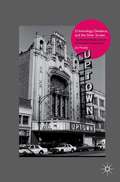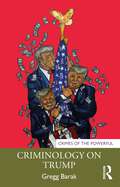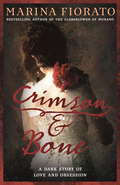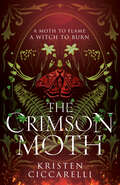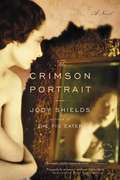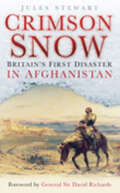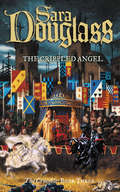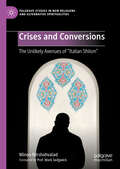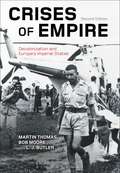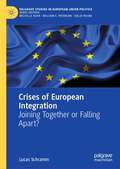- Table View
- List View
Criminology: A Critical Overview
by Ezzat A. FattahWritten by an internationally renowned authority in the field, the founder of the highly regarded School of Criminology at Simon Fraser University, the book draws heavily on research done on three Continents: North America, Europe and Australia, to trace the discipline's historical evolution, its current problems, disappointing achievements, and promising trends. It concludes with a prospective look at the future of criminology and criminology of the future. Although the perspective is critical, the author's critique is constructive and he expresses a healthy optimism about the discipline's future and offers several guidelines as to how current deficiencies could be remedied and present gaps could be addressed.
Criminology, Deviance, and the Silver Screen: The Fictional Reality and the Criminological Imagination
by J. FrauleyThis text argues for the usefulness of fictional realities for criminological theorizing and analysis. It illustrates that a creative and critical social scientific practice requires craft norms rather than commercial norms that threaten to completely colonize higher education.
The Criminology of War
by Ruth JamiesonThe essays selected for this volume provide an overview of the range of issues confronting scholars interested in the complex and multiple relationships between war and criminality, and map the many connections between war, security, governmentality, punishment, gender and crime. The collection draws on the recent theoretical advances made by both criminologists and scholars from cognate disciplines such as law, politics, anthropology and gender studies, in order to open out criminological thinking about what war is, how it is related to crime and how these war/crime relationships reach into peace. The volume features contributions from key thinkers in the field and serves as a valuable resource for academics and students with an interest in the criminology of war.The essays selected for this volume provide an overview of the range of issues confronting scholars interested in the complex and multiple relationships between war and criminality, and map the many connections between war, security, governmentality, punishment, gender and crime. The collection draws on the recent theoretical advances made by both criminologists and scholars from cognate disciplines such as law, politics, anthropology and gender studies, in order to open out criminological thinking about what war is, how it is related to crime and how these war/crime relationships reach into peace. The volume features contributions from key thinkers in the field and serves as a valuable resource for academics and students with an interest in the criminology of war.
The Criminology of War (International Library Of Criminology, Criminal Justice And Penology - Second Ser. #2)
by Ruth JamiesonThe essays selected for this volume provide an overview of the range of issues confronting scholars interested in the complex and multiple relationships between war and criminality, and map the many connections between war, security, governmentality, punishment, gender and crime. The collection draws on the recent theoretical advances made by both criminologists and scholars from cognate disciplines such as law, politics, anthropology and gender studies, in order to open out criminological thinking about what war is, how it is related to crime and how these war/crime relationships reach into peace. The volume features contributions from key thinkers in the field and serves as a valuable resource for academics and students with an interest in the criminology of war.The essays selected for this volume provide an overview of the range of issues confronting scholars interested in the complex and multiple relationships between war and criminality, and map the many connections between war, security, governmentality, punishment, gender and crime. The collection draws on the recent theoretical advances made by both criminologists and scholars from cognate disciplines such as law, politics, anthropology and gender studies, in order to open out criminological thinking about what war is, how it is related to crime and how these war/crime relationships reach into peace. The volume features contributions from key thinkers in the field and serves as a valuable resource for academics and students with an interest in the criminology of war.
Criminology on Trump (Crimes of the Powerful)
by Gregg BarakCriminology on Trump is a criminological investigation of the world’s most successful outlaw, Donald J. Trump. Over the course of five decades, Donald Trump has been accused of sexual assault, tax evasion, money laundering, non-payment of employees, and the defrauding of tenants, customers, contractors, investors, bankers, and charities. Yet, he has continued to amass wealth and power. In this book, criminologist and social historian Gregg Barak asks why and how?This book examines how the United States precariously maintains stability through conflict in which groups with competing interests and opposing visions struggle for power, negotiate rule breaking, and establish criminal justice. While primarily focused on Trump’s developing character over three quarters of a century, it is also an inquiry into the changing cultural character and social structure of American society. It explores the ways in which both crime and crime control are socially constructed in relation to a changing political economy.An accessible and compelling read, this book is essential for all those who seek a criminological understanding of Donald Trump’s rise to power.
Criminology on Trump (Crimes of the Powerful)
by Gregg BarakCriminology on Trump is a criminological investigation of the world’s most successful outlaw, Donald J. Trump. Over the course of five decades, Donald Trump has been accused of sexual assault, tax evasion, money laundering, non-payment of employees, and the defrauding of tenants, customers, contractors, investors, bankers, and charities. Yet, he has continued to amass wealth and power. In this book, criminologist and social historian Gregg Barak asks why and how?This book examines how the United States precariously maintains stability through conflict in which groups with competing interests and opposing visions struggle for power, negotiate rule breaking, and establish criminal justice. While primarily focused on Trump’s developing character over three quarters of a century, it is also an inquiry into the changing cultural character and social structure of American society. It explores the ways in which both crime and crime control are socially constructed in relation to a changing political economy.An accessible and compelling read, this book is essential for all those who seek a criminological understanding of Donald Trump’s rise to power.
Crimson and Bone: A Dark Story Of Love And Obsession
by Marina Fiorato'A rich jewel of a story, full of desire and danger' - Julie Cohen. A dark tale of love and obsession, perfect for fans of The Mermaid and Mrs Hancock and The Wicked Cometh. London, 1853. Annie Stride has nothing left to live for - she is a penniless prostitute, newly evicted from her home and pregnant. On the night she plans to cast herself from Waterloo Bridge into the icy waters of the Thames, her life is saved by Francis Maybrick Gill, a talented pre-Raphaelite painter - and her world is changed forever.Francis takes Annie as his artist's muse, elevating her from fallen woman to society's darling. With her otherworldly beauty now the toast of London, her dark past is left far behind. But Annie's lavish new life is not all it seems - and there are some who won't let her forget where she came from...'A thrilling tale of love, lust and revenge' The Lady'A captivating gothic blend of mystery and romance' Sunday Mirror'Exquisite...this is historical fiction at its best' - Book Literarti Reviews'Gothic, dark [and] rich with atmosphere' - Louise Loves books'A glorious story of art and passion' - Tea Party Princess'Dazzling' Goodreads Reviewer'Captivating' Goodreads Reviewer
The Crimson Moth (The Crimson Moth #1)
by null Kristen CiccarelliEnemies-to-lovers doesn't get more high stakes than a witch and a witch hunter falling in love in bestselling author Kristen Ciccarelli's latest romantic fantasy. On the night Rune’s life changed forever, blood ran in the streets. Now, in the aftermath of a devastating revolution, witches have been diminished from powerful rulers to outcasts ruthlessly hunted due to their waning magic, and Rune must hide what she is. Spending her days pretending to be nothing more than a vapid young socialite, Rune spends her nights as the Crimson Moth, a witch vigilante who rescues her kind from being purged. When a rescue goes wrong, she decides to throw the witch hunters off her scent and gain the intel she desperately needs by courting the handsome Gideon Sharpe – a notorious and unforgiving witch hunter loyal to the revolution – who she can't help but find herself falling for. Gideon loathes the decadence and superficiality Rune represents, but when he learns the Crimson Moth has been using Rune’s merchant ships to smuggle renegade witches out of the republic, he inserts himself into her social circles by pretending to court her right back. He soon realizes that beneath her beauty and shallow façade, is someone fiercely intelligent and tender who feels like his perfect match. Except, what if she’s the very villain he’s been hunting? Kristen Ciccarelli’s The Crimson Moth is the thrilling start to a romantic fantasy duology where the only thing more treacherous than being a witch…is falling in love. Spice 🥵: 🌶️ Tropes ✨: Witch x Witch Hunter 👩👨 Enemies to Lovers ❤️🔥 Heroine Vigilante 🥷 Outlawed Magic 🪄❌ Brother’s Best Friend 👩❤️👨 High Stakes ⚠️ Slow Burn Romance 🔥❤️ Forbidden Desires 🚫❤️ Epic Tension 🥵 Published in the US as Heartless Hunter
The Crimson Portrait: A Novel
by Jody ShieldsSet in England during World War I, this haunting love story by the author of the bestselling The Fig Eater makes unforgettably real the ravages of love and war.
Crimson Snow: Britain's First Disaster in Afghanistan (Sutton Ser.)
by Jules StewartIn the mid-nineteenth century, the British and Russian Empires played the ‘Great Game,’ a rivalry for supremacy in Central Asia. To secure a ‘buffer zone’ in Afghanistan, between India and Russian territory, Britain launched the First Anglo-Afghan War in 1838. Initial success, including the imposition of a puppet regime supported by too few troops (a situation that has great resonance today), was followed by complete disaster in 1842, with 4,500 soldiers and 12,000 civilian camp followers killed by rebellious Afghans. Only one Briton is known to have escaped the massacre. This compelling story of imperial misadventure is told by Jules Stewart, a former Reuters journalist with considerable experience in the region and a specialist in North-West Frontier history, and has a foreword from General Sir David Richards, Chief of the General Staff and a former NATO commander in Afghanistan. It provides important parallels with our current commitments in this graveyard of ambitions, and illustrates how little has been learnt from the past.
The Crinan Canal
by Marian PallisterKnown as 'Britain's most beautiful shortcut', the Crinal Canal runs from Ardrishaig on Loch Fyne nine miles across the Kintyre peninsula to the west coast of Scotland. Designed by John Rennie after initial survey work by James Watt in 1771, the canal was opened in 1801, with further improvements made by Thomas Telford in the second decade of the nineteenth century. The canal was originally planned to save commercial ships having to make the long journey from the industrial region around Glasgow round the Mull of Kintyre to reach the west coast and Hebridean islands. By 1854, 33,000 passengers, 22,000 sheep and 2000 cattle had been transported along it. These days the canal is a popular route for leisure craft. In the book Marian Pallister tells the story of the canal from its origins to the present day, discussing how it was built, who built it, how it changed life in the surrounding areas, and how it has been used.
Crip-queere Körper: Eine kritische Phänomenologie des Theaters (Theater #154)
by Mirjam KreuserWie steht es um die crip-queere Sichtbarkeit auf der Theaterbühne? In der Beschäftigung mit Performances von behinderten und queeren Künstler*innen befragt Mirjam Kreuser die Theaterwissenschaft im Allgemeinen und die phänomenologische Aufführungsanalyse im Besonderen zu ihrer normativen Orientierung. Die Analyse der Performance-Reihe Criptonite (Konzept: Nina Mühlemann, Edwin Ramirez) beschäftigt sich nicht nur mit dem sogenannten cripping und queering als ästhetische, sondern auch als wissenschaftliche Praxis. Das Ergebnis ist ein Vorschlag hin zu einem Entwurf von Kompliz*innenschaft in künstlerischer und akademischer Praxis.
The Crippled Angel: Book Three Of The Crucible Trilogy (The Crucible Trilogy #3)
by Sara DouglassThe third book of The Crucible, the exciting historical fantasy series from the author of the popular Axis Trilogy.
Crips and Bloods: A Guide to an American Subculture (Guides to Subcultures and Countercultures)
by Herbert C. CoveyThis book provides a concise and engaging examination of the subculture of the Crips and Bloods—the notorious street gangs that started in Los Angeles, but have now spread throughout the United States.Despite the dangers and harsh realities intrinsic to street life and criminal activity, the no-holds-barred lifestyle of gangs continues to interest mainstream America. This provocative book provides an insider's look into the subculture of two of the most notorious street gangs—the Crips and the Bloods. Crips and Bloods: A Guide to an American Subculture traces the evolution of the two gangs, covering their origins in South Central Los Angeles to the organizations' current presence throughout the United States. The author analyzes the ways in which the gang subculture is created, promoted, and perpetuated; shows how the groups currently recruit their members; and explores the ways Crip and Blood culture has expanded beyond the gangs into the larger mainstream society.
Crips and Bloods: A Guide to an American Subculture (Guides to Subcultures and Countercultures)
by Herbert C. CoveyThis book provides a concise and engaging examination of the subculture of the Crips and Bloods—the notorious street gangs that started in Los Angeles, but have now spread throughout the United States.Despite the dangers and harsh realities intrinsic to street life and criminal activity, the no-holds-barred lifestyle of gangs continues to interest mainstream America. This provocative book provides an insider's look into the subculture of two of the most notorious street gangs—the Crips and the Bloods. Crips and Bloods: A Guide to an American Subculture traces the evolution of the two gangs, covering their origins in South Central Los Angeles to the organizations' current presence throughout the United States. The author analyzes the ways in which the gang subculture is created, promoted, and perpetuated; shows how the groups currently recruit their members; and explores the ways Crip and Blood culture has expanded beyond the gangs into the larger mainstream society.
Crises and Challenges for the European Union (The European Union Series)
by Mark Rhinard, Neill Nugent and William PatersonThe crises of the European Union extend beyond the challenges of Covid-19, Brexit, the Eurozone, and mass migration, cutting to the core of the EU itself. Taking a structural rather than event-based approach, this text unpacks all aspects of the EU in crisis and analyses the implications of these crises for the EU and its member states. This edition argues that crises and challenges are no longer unique and discreet events facing the EU, but rather, they are better understood as sustained conditions that have changed the relationships between member states, the functioning of institutions, the nature of public engagement and the prospects for integration. Chapters broach institutional issues as well as specific policy challenges, covering questions of legitimacy and leadership and offering a full chapter on democracy and Euroscepticism. Working within both historical and theoretical frameworks, this is the perfect companion for those studying and researching contemporary challenges facing the EU, European integration, political crisis management and transboundary crises more broadly.
Crises and Challenges for the European Union (The European Union Series)
The crises of the European Union extend beyond the challenges of Covid-19, Brexit, the Eurozone, and mass migration, cutting to the core of the EU itself. Taking a structural rather than event-based approach, this text unpacks all aspects of the EU in crisis and analyses the implications of these crises for the EU and its member states. This edition argues that crises and challenges are no longer unique and discreet events facing the EU, but rather, they are better understood as sustained conditions that have changed the relationships between member states, the functioning of institutions, the nature of public engagement and the prospects for integration. Chapters broach institutional issues as well as specific policy challenges, covering questions of legitimacy and leadership and offering a full chapter on democracy and Euroscepticism. Working within both historical and theoretical frameworks, this is the perfect companion for those studying and researching contemporary challenges facing the EU, European integration, political crisis management and transboundary crises more broadly.
Crises and Conversions: The Unlikely Avenues of "Italian Shiism" (Palgrave Studies in New Religions and Alternative Spiritualities)
by Minoo MirshahvaladThis book explores the phenomenon of conversion to Shi'a Islam in Italy. It thoroughly examines the motivations behind this religious transition and scrutinizes the doctrinal characteristics that Shiism incorporates thanks to the contributions of Italian converts. The text emphasizes the significance of René Guénon’s Traditionalism as a pivotal factor in driving this religious mobility. Additionally, the book delves into the writings of figures such as Julius Evola, who introduced Guénon to Italy, shedding light on Evola’s impact on the youth in the post-World War II era. Furthermore, it evaluates the influence of Henry Corbin on this spiritual journey. To realize this study, between 2018 and 2023, Minoo Mirshahvalad employed multidisciplinary methods that integrated sociology and history.
Crises and Migration: Critical Perspectives from Latin America (Latin American Societies)
by Enrique Coraza de los Santos Luis Alfredo Arriola VegaThis book critically examines the association between the notions of crisis and migration in the context of Latin America, and from three different perspectives: first, it analyzes the discourses based on the concept of crisis employed by the media, academic researchers, civil society organizations and the state to frame human mobility issues; second, it investigates migrants’ agency under conditions of crisis; and third, it discusses whether “migration crisis” is a conjunctural or structural phenomenon in the region. Chapters in this contributed volume investigate the crisis-migration nexus in seven Latin American countries – Argentina, Brazil, Colombia, Costa Rica, Mexico, Nicaragua and Uruguay – by discussing different human mobility phenomena, such as the migrant caravans that departed from Central America bound to Mexico and the United States; the Nicaraguan exodus caused by the political crisis in the country; the perception of Venezuelan migrants in Colombia’s media; the presence of Caribbean migrants in Brazil, Uruguay and Argentina. Crisis and Migration: Critical Perspectives from Latin America will be of interest to a wide range of social scientists interested in migration studies, as well as to policy makers and civil society organizations. This book offers a fresh look at the way we conceive, represent, and think about the relationship between crisis and human mobility. As the volume’s contributions show, a critical examination of the notion of crisis is a first step towards a more comprehensive understanding of the plight of present-day migrants worldwide.
Crises and Transformation in the Mediterranean World: Lessons from Catalonia (Palgrave Studies in Economic History)
by Jordi Catalan VidalThis edited collection presents an economic history of Catalonia and its economic crises, from Roman times to the political difficulties of the present day. It considers how the strong identity of the Catalan people has been reinforced in critical episodes such as the commercial revolution of the Late Medieval Age, the 1640 rebellion, the Succession War of 1705-1714, the industrial revolution of the eighteenth and nineteenth centuries, and the strong repression during early Francoism. The book also explores how historical parallels from Catalonia’s past might shed light on the long-term consequences of the Great Recession of 2007-9 and recovery in the EU, showing how the typical Mediterranean approach of adjusting to crises by depreciating currencies and expanding public deficits has been less straightforward during the most recent financial crisis. A particularly deep slump has contributed to fostering the claim for independence of Catalonia in recent times, echoing larger dissatisfaction with EU monetary policy. With a comprehensive overview of major events in Catalonian economic history and their broader implications to European political economy and development, this book will be of interest to students and academics in economic history, social history, and monetary economics.
Crises in the Atlantic Alliance: Affect and Relations among NATO Members
by L. EznackThrough a theoretical and empirical examination of the 1956 Suez Crisis, the 1966 NATO crisis, and the 2003 Iraq crisis, Eznack explores the connections between affect and emotion, the occurrence of crises, and the repair of those crises in close allies' relationships, and provides a new perspective on alliances and friendly relations among states.
The Crises of Civilization: Exploring Global and Planetary Histories
by Dipesh ChakrabartyThe world created by the legacies of empire and colonialism now confronts some deep crises of civility, precipitated by globalization and climate change. In this volume, Dipesh Chakrabarty examines these distinct—but interrelated—issues side by side. Varied ideas of civilization and humanism have shaped notions of a global humanity in the lingering twilight of the European empires. Detailing these ideas, in the section titled ‘Global Worlds’, Chakrabarty outlines the conflicts and connections that arise from global encounters in our postcolonial age. The second section, ‘The Planetary Human’, on the other hand, explores the significance of planetary climate change for humanistic and postcolonial thought. Chakrabarty argues that such change demands not only critiques of capitalism and inequality, but also new thinking about the human species as a whole—our patterns of justice, writing of history, and relationship with nature in the age of the Anthropocene. The global is human-centric in construction; the planetary involves many other actors and thus includes the thorny question of how we go beyond the anthropocentric to discuss and conceptualize the agency of the non-human.
Crises of Empire: Decolonization and Europe's Imperial States
by Martin Thomas Bob Moore L. J. ButlerCrises of Empire offers a comprehensive and uniquely comparative analysis of the history of decolonization in the British, French and Dutch empires. By comparing the processes of decolonization across three of the major modern empires, from the aftermath of the First World War to the late 20th century, the authors are able to analyse decolonization as a long-term process. They explore significant changes to the international system, shifting popular attitudes to colonialism and the economics of empire. This new edition incorporates the latest developments in the historiography, as well as:- Increased coverage of the Belgian and Portuguese empires- New introductions to each of the three main parts, offering some background and context to British, French and Dutch decolonization- More coverage of cultural aspects of decolonization, exploring empire 'from below' This new edition of Crises of Empire is essential reading for all students of imperial history and decolonization. In particular, it will be welcomed by those who are interested in taking a comparative approach, putting the history of decolonization into a pan-European framework.
Crises of Empire: Decolonization and Europe's Imperial States
by Martin Thomas Bob Moore L. J. ButlerCrises of Empire offers a comprehensive and uniquely comparative analysis of the history of decolonization in the British, French and Dutch empires. By comparing the processes of decolonization across three of the major modern empires, from the aftermath of the First World War to the late 20th century, the authors are able to analyse decolonization as a long-term process. They explore significant changes to the international system, shifting popular attitudes to colonialism and the economics of empire. This new edition incorporates the latest developments in the historiography, as well as:- Increased coverage of the Belgian and Portuguese empires- New introductions to each of the three main parts, offering some background and context to British, French and Dutch decolonization- More coverage of cultural aspects of decolonization, exploring empire 'from below' This new edition of Crises of Empire is essential reading for all students of imperial history and decolonization. In particular, it will be welcomed by those who are interested in taking a comparative approach, putting the history of decolonization into a pan-European framework.
Crises of European Integration: Joining Together or Falling Apart? (Palgrave Studies in European Union Politics)
by Lucas SchrammThe book offers explanations for the striking variation in the outcomes of European integration crises. It analyzes eight major cases over the entire integration process, starting from the early 1950s and lasting until very recently. All cases went beyond a single policy field or member state but affected key features, principles, and objectives of European integration. As such, they qualify as “constitutional crises”. My cases comprise the crisis of the European Defence Community (1952-54); the empty chair crisis (1965-66); the oil crisis (1973-74); the budgetary rebate crisis (1979-84); the end of the Cold War crisis (1989-92); the Constitutional Treaty crisis (2004-07); the Euro crisis (2009-12); and the migration crisis (2015-16). Taking a historical-comparative perspective, the book shows that crises have been an integral part of the European integration process since its beginning. European integration, after all, started with a major setback when member states in 1954 failedto realize plans for a European army through the European Defense Community.

